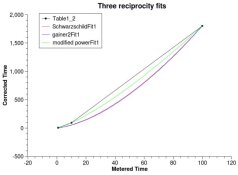Murray@uptowngallery
Member
I'm confused by apparently conflicting info.
I have a box of Fomapan 200. It doesn't say Creative, or other variant names. I downloaded a data sheet, it is shows what I have in the past called the worst 'old tech' reciprocity failure characteristics I have ever seen. 4 stops or x18 multiplier at 100 seconds.
As I'm browsing the Web, I see someone claiming Fomapan 200 Creative has high tech T-grain, blah-blah. I thought T-grain films were more modern than (pyramidal?) the old classic types, and the 4 stops and T-grain don't go together for me.
Someone else was discussing Efke 50, couldn't find data for reciprocity failure, and someone else provided Efke 25 data with increments like 1/3 stop at 1 sec, 1/2 at 10 sec and 2/3 at 100 sec.
THAT sounds like average T-grain film.
Now, I know Efke and Foma are not the same. Efke says Croatia I think and Foma said Czech Republic.
Maybe what's confusing me is the crossover packaging with Arista, Freestyle, & the former J&C, and 'helpful' statements from people that 'this and that' are the same, despite different brands.
I do also have some Efke 50 and wonder what behavior that film REALLY has,
Do I dare ask if there is any fact in the claims of various films changing source/manufacturer over a period of time? If that's the case, how does one know what one has stored if the data doesn't remain constant.
Thanks
I have a box of Fomapan 200. It doesn't say Creative, or other variant names. I downloaded a data sheet, it is shows what I have in the past called the worst 'old tech' reciprocity failure characteristics I have ever seen. 4 stops or x18 multiplier at 100 seconds.
As I'm browsing the Web, I see someone claiming Fomapan 200 Creative has high tech T-grain, blah-blah. I thought T-grain films were more modern than (pyramidal?) the old classic types, and the 4 stops and T-grain don't go together for me.
Someone else was discussing Efke 50, couldn't find data for reciprocity failure, and someone else provided Efke 25 data with increments like 1/3 stop at 1 sec, 1/2 at 10 sec and 2/3 at 100 sec.
THAT sounds like average T-grain film.
Now, I know Efke and Foma are not the same. Efke says Croatia I think and Foma said Czech Republic.
Maybe what's confusing me is the crossover packaging with Arista, Freestyle, & the former J&C, and 'helpful' statements from people that 'this and that' are the same, despite different brands.
I do also have some Efke 50 and wonder what behavior that film REALLY has,
Do I dare ask if there is any fact in the claims of various films changing source/manufacturer over a period of time? If that's the case, how does one know what one has stored if the data doesn't remain constant.
Thanks












